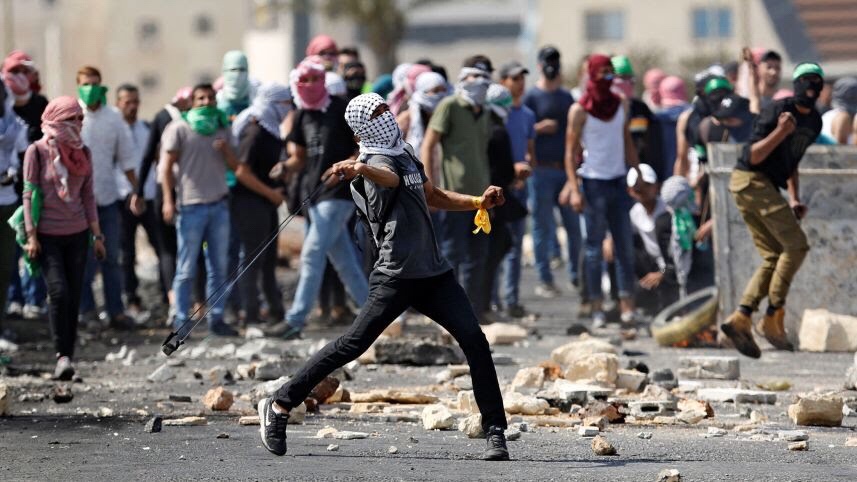
A Palestinian protester from Birzeit University throws stones during clashes with Israeli troops near the Jewish settlement of Beit El, near the West Bank city of Ramallah, on October 2, 2018. AP Photo/Majdi Mohammed, File
Rising Terrorism in West Bank Overshadows Optimism Around Gaza-Israel Deal
Commanders describe a mixture of lone-wolf attacks, local independent groups and terror cells receiving orders from Hamas leadership in Lebanon and Gaza
In the territories, the Palestinians seem to be having difficulty reconciling themselves to Netanyahu’s absolute conviction that the conflict regarding the occupation is over and done. Appearing before the Knesset Foreign Affairs and Defense Committee earlier this week, the head of the Shin Bet security service, Nadav Argaman, warned about the possibility of a steep increase in terrorism in the West Bank. Within the past several days, two Israelis were lightly injured by gunfire in the West Bank, on a bus north of Ramallah, and two stabbing attempts were foiled.
Separate visits to two regional brigade commanders in the West Bank within a week paint a similar picture. The number of rock-throwing incidents has been on the rise, as have the number of attempted terrorist attacks and the number of intelligence warnings of attacks in the planning stages.
Particularly in the northern West Bank, a cycle of revenge has developed that is far from over. Two Israeli citizens were shot to death in the Barkan industrial zone last month and a Palestinian woman was killed by a rock thrown at her car, apparently by young Israelis, which prompt additional acts of revenge.
The fact that the Barkan killer has not yet been apprehended is causing unease among extreme right-wing activists. The Shin Bet and the Israeli army have been investing tremendous resources in trying to catch the terrorist, but to no avail so far. The criticism in the media over the failure to apprehend him is presented rather strangely, suggesting that if only the top brass would only get up an hour earlier, as industrious reporters do, the whole thing would long have been resolved.
Brigade commanders report a combination of lone-wolf attackers, some motivated by serious personal problems and others inspired by terrorist attacks committed by others. There are also reports of independent cells and a growing trend of terrorist cells funded and directed from Hamas command centers in Lebanon and Gaza.
Temple Mount in Jerusalem along the lines of the rioting that followed the installation of metal detectors there in 2017; a series of clashes between Palestinians and West Bank settlers; or instability caused by an open leadership struggle within the Palestinian Authority.
Hamas’ attempts to launch a terrorist campaign in the West Bank are divorced from efforts at coming to an arrangement with Israel over long-term calm on the Gaza border. The main obstacle that the Islamist movement faces in the West Bank is a dearth of engineers who can assemble explosives. Once they have built up adequate knowledge to produce deadly devices again, the threat of suicide attacks will resurface.
Surprisingly, a certain level of optimism is prevailing in Gaza. After the fuel funded by Qatar arrived in the Strip, a temporary arrangement was agreed upon that will make it possible to transfer tens of millions of dollars from Qatar for infrastructure projects and to pay salaries to government employees in Gaza. At present, Hamas is exerting control over the demonstrations along the border fence with Israel and is restraining other violence. If this positive momentum can be maintained for this Friday's border demonstrations, perhaps the prospect exists of putting the events of the past several months behind us.
No comments:
Post a Comment